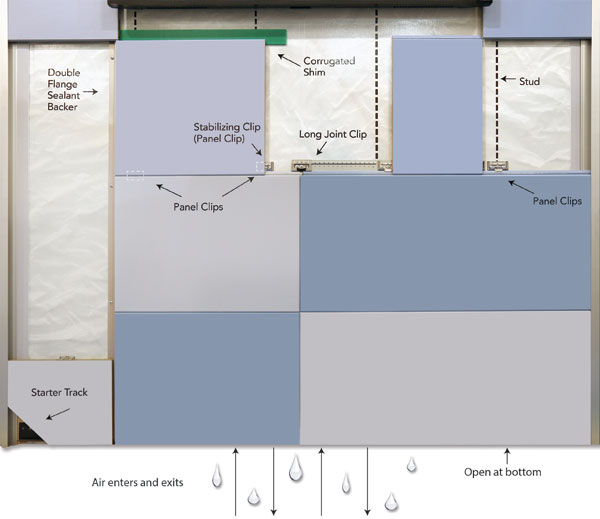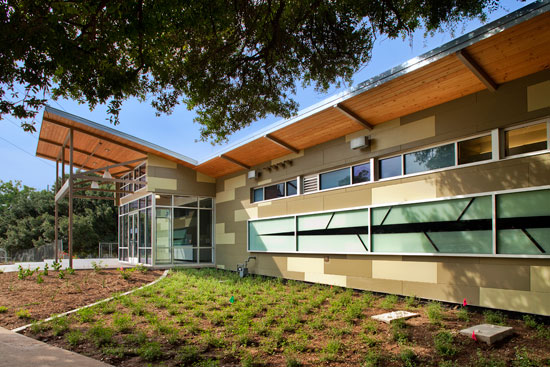Design Innovations Using Fiber Cement in Commercial Construction
Panel Joint Types
Manufacturers of fiber cement architectural wall panels offer two fundamental choices in the types of panel joints and systems available, although different manufacturers may or may not offer both. The basic choice is between open joint assemblies as compared to closed jointed assemblies. Each type is discussed and compared as follows:
▶ Open joint systems. This type of system is used to create a ventilated, rainscreen type of exterior cladding system. These types of systems emerged from product needs to hold metal or fiber cement wall materials away from the substrate and literally provide a permeable screen against rain and other weather. As such, the water and air barriers over the sheathing are critical elements since they are the true exterior skin barriers and require significant attention to detail to function properly. When properly designed, open joint systems allow for air and water to both penetrate and drain out from behind the panels and away from the rest of the wall assembly. As such, they are fully ventilated between the panels and the substrate. Naturally, that means they require the space to perform this function meaning that some additional depth is needed in the wall assembly.
There are a number of details that need to be properly addressed when using open joint systems. The most basic is that the panels are commonly installed on a system of metal hat and J-channels to hold them off of the substrate and the weather barrier. This is where the additional wall assembly depth comes into play but it also means that the weather barrier is penetrated by the fasteners to hold the metal channels in place.
The barrier should be self-sealing therefore and due to the open joints, also needs to be UV stabilized since it is partly exposed. Installing the architectural wall panels to the metal channels usually involves a series of slipping points instead of fixed points to allow for proper adjustment and for expansion and contraction. When it comes to corners, the panels need to be detailed to come together or express a corner joint using the appropriate metal channels and maintain the proper alignment across two adjoining facades. In some cases, the joints can be filled or closed with materials suited to a particular manufacturer's system but the rainscreen function is likely still meant to be kept. And when it comes to panel sizes, commercial architectural wall panels are available in standard or custom sizes that may minimize the amount of field modification or cutting that is needed. If they are field modified, however, the edges of the panels will need to be field finished to protect the integrity of the panel.
▶ Closed joint systems. This type of system lives up to its name by eliminating the open joints between panels and instead creating a smooth, continuous surface on the exterior. This more closely resembles metal or composite exterior wall panels that are often used to achieve the same fairly continuous effect. Fiber cement panels are generally less expensive and easier to install than metal panels in many cases, however.

Image courtesy of Nichiha USA, Inc.
Closed joint systems rely on tight fitting shiplap panels that are held in place with low-profile clips instead of hat channels.
Closed joint systems are inherently simpler to design and install than open joint systems. Since the closed joints are designed not to allow bulk water to penetrate into the cavity, the space between the cladding and the substrate can be greatly reduced. The panels still function as a drained and back ventilated rainscreen but just in a much smaller depth. This also means that the attachment of the panels in closed joint systems do not require metal channels, but instead usually rely on a concealed, narrow, clip system spaced at appropriate intervals. The clips use less material and require less time for installation, all of which translates to less cost.
The actual panel joints are often factory formed to lap or join fairly tightly, sometimes with the addition of factory applied foam gaskets along the edges that helps seal the joints once installed. All of this means that the substrate barriers are not exposed and can be selected from more options, particularly without the concern for UV exposure. When it comes to corners, the panels can fit tightly or be butt joined to continue the appearance across adjoining facades. Of course, just like most building materials, long facades will require expansion joints to be designed in that relate to the expansion and control joint mechanisms for the building. Closed joint systems can be modified in the field just like open joint systems but proper planning and coordination with available manufactured sizes can minimize that. Any field modifications will need to address the edges of the panels to be sure the proper fit is maintained.
Panel Design Options
When working with fiber cement architectural wall panels, there are some significant design options that can be selected and worked with. The most fundamental is the size of the architectural wall panels which will vary by manufacturer. The height and length of the panels can range from smaller easy to handle sizes up to large format sizes. It is possible to work with a manufacturer to have multiple sizes on a single project and thus meet the design needs while minimizing the need for any field modifications. Consultation with manufacturers during the design phase can help with identifying the best sizing options and final selections for a specific project.
The other significant design option with fiber cement is the texture and finish of the wall panels. Smooth surfaces are available that emulate the contemporary sleek look of other materials such as metals. For other situations, a wood textured look may be desirable and is readily available as well. All are offered in a range of standard and custom colors to suit design needs and it is becoming common to see mixed colors intentionally used on a particular façade. Some manufacturers also offer brick and stone textures in appropriately matched colors to allow for a façade solution that comprises less weight and less than depth than traditional stone or masonry construction.
Testing and Performance of Fiber Cement Architectural Wall Panels
Like most manufactured building products, there are a number of relevant and useful tests that fiber cement architectural wall panels are subjected to in order to demonstrate their capabilities to perform in commercial settings. However, the issue is that many of these tests are designed primarily for other types of wall assemblies and have limited usefulness on rainscreen systems. Some of the commonly referred to tests are summarized as follows.
ASTM E283 Standard Test Method for Determining Rate of Air Leakage
This test method covers a standard laboratory procedure for determining the air leakage rates of exterior windows, curtain walls, and doors under specified differential pressure conditions across a sample or specimen product. The method calls for constant temperature and humidity across the specimen and is intended to measure only such leakage associated with the assembly sample and not the field installation. This test is often referenced for rainscreen type of walls, but the reality is that the cavity depth can alter the results and may not report readily comparable results between different systems.
ASTM E330 Standard Test Method for Structural Performance by Uniform Static Air Pressure Difference
This test method describes the determination of the structural performance of exterior windows, doors, skylights, and curtain walls under uniform static air pressure differences, using a test chamber. This test method is applicable to curtain wall assemblies and is a standard procedure for determining structural performance under uniform static air pressure difference. This typically is intended to represent the effects of a wind load on exterior building surface elements. However, the actual loading on building surfaces is quite complex, varying with wind direction, time, height above ground, building shape, terrain, surrounding structures, and other factors. This test method is intended only for evaluating the structural performance associated with the specified test specimen and not the structural performance of adjacent construction. As such, it is useful but not necessarily completely applicable or accurate when looking at rainscreen architectural wall panels.
ASTM E331 Standard Test Method for Water Penetration of Exterior Windows, Skylights, Doors, and Curtain Walls by Uniform Static Air Pressure Difference
This test method is a testing standard that describes the procedures to determine the water penetration resistance of windows, curtain walls, skylights, and doors when water is applied using a calibrated spray apparatus while simultaneously applying uniform static pressure to opposite sides of the test specimen. The testing is performed by applying water to the exterior of the test specimen while lowering the pressure inside by means of an air chamber built on the inside of the test specimen. The water spray system has nozzles spaced on a grid to deliver water in such a manner as to wet all of the test specimen uniformly, wetting those areas vulnerable to water penetration. The calibrated spray apparatus delivers water to the test specimen at a rate of 5.0 gal/ft²-h at a minimum testing pressure of 6.24 psf. It is attempting to replicate the condition of wind driven rain on a building surface. Although intended more for fenestration than for opaque wall surfaces, it can be useful to determine if the wall assembly behind architectural wall panels is resistant to water penetration.










